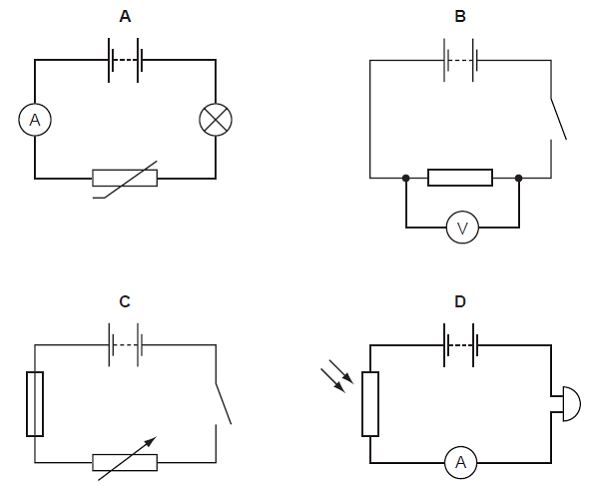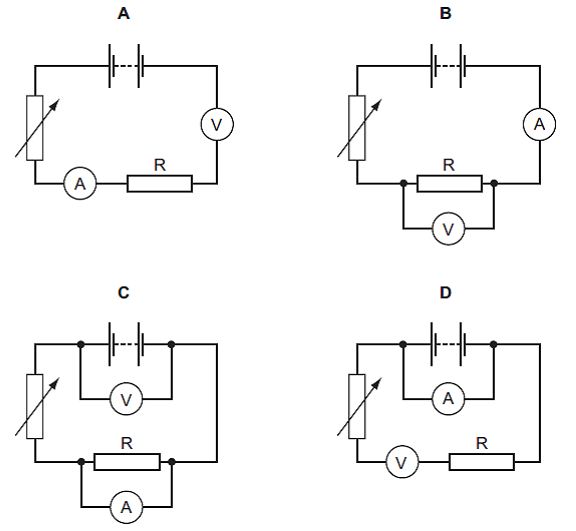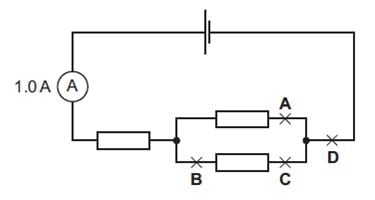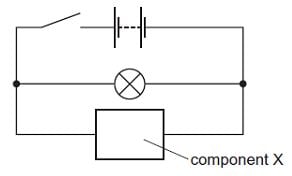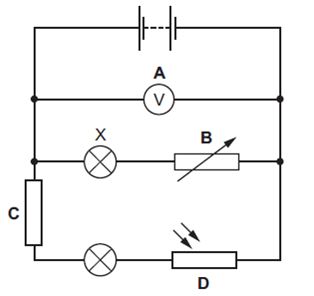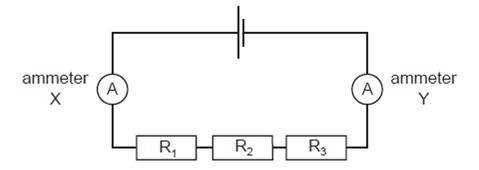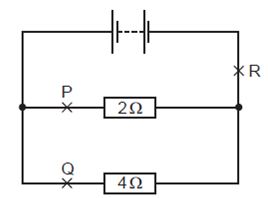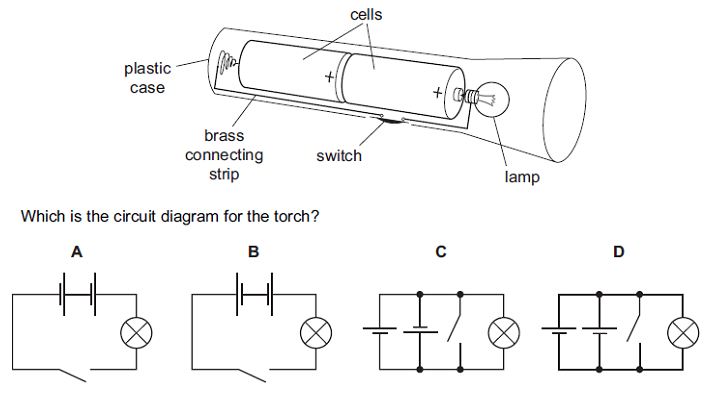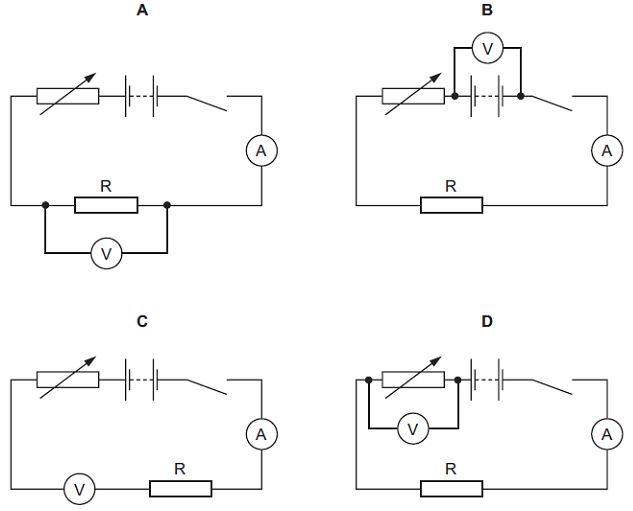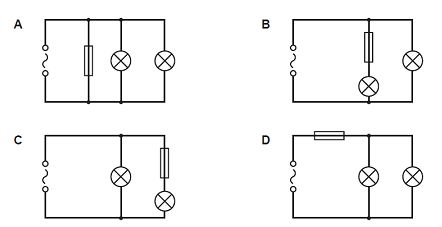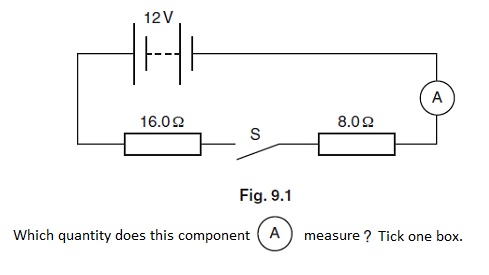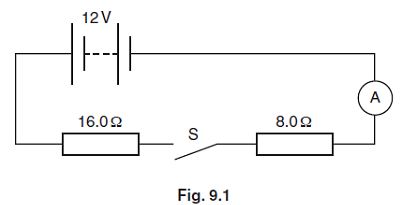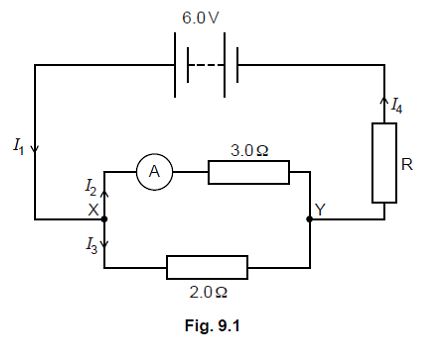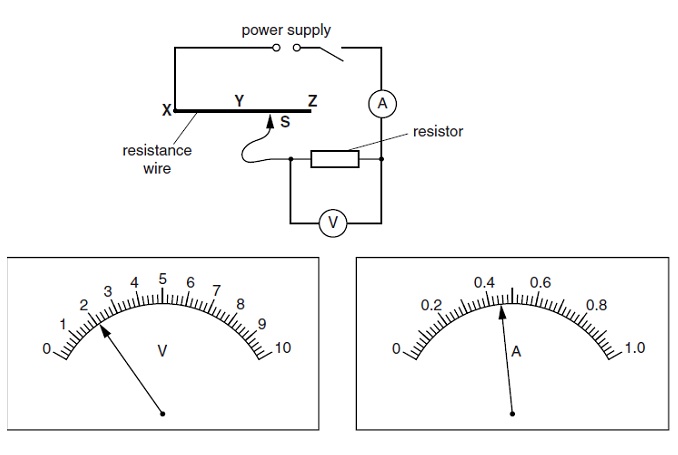Ohmic Obstacles: Resistance To Electric Current Quiz

Resistance is defined as the opposition to current flow in an electrical circuit. Play this exciting quiz that covers topics from resistance to electric current to gauge your knowledge. The quiz contains various questions ranging from easy, medium, to hard level that will clarify your concepts about the topic and provide you with valuable information that would be of immense benefit if you sit for an exam in the near future. All the best!
- 1.
In which unit is the potential difference measured?
- A.
Ampere
- B.
Ohm
- C.
Volt
- D.
Watt
Correct Answer
C. VoltExplanation
The potential difference is measured in volts. Volt is the unit of measurement for electric potential difference or voltage. It represents the amount of electrical potential energy per unit charge.Rate this question:
-
- 2.
Which circuit contains a fuse?
- A.
A
- B.
B
- C.
C
- D.
D
Correct Answer
C. CExplanation
Circuit C contains a fuse. A fuse is a safety device that is designed to protect an electrical circuit from damage caused by excessive current. It is typically a small, thin wire that melts when the current exceeds a certain limit, breaking the circuit and preventing further damage. In circuit C, the fuse is placed in series with the other components, indicating that it is intended to protect the circuit from overcurrent.Rate this question:
-
- 3.
Which of these is a variable resistor ?
- A.
A
- B.
B
- C.
C
- D.
D
Correct Answer
C. CExplanation
Option C is a variable resistor because it has a movable contact that can be adjusted to change the resistance value. Option A, B, and D are not variable resistors as they do not have a movable contact to adjust the resistance.Rate this question:
-
- 4.
Which circuit should be used to determine the resistance of the resistor R?
- A.
A
- B.
B
- C.
C
- D.
D
Correct Answer
B. BExplanation
Circuit B should be used to determine the resistance of the resistor R because it has a known voltage source connected in series with the resistor and a known current measuring device connected in parallel with the resistor. By measuring the voltage across the resistor and the current flowing through it, the resistance can be calculated using Ohm's law (R = V/I). Circuit B provides the necessary components and connections to accurately measure the resistance of the resistor R.Rate this question:
-
- 5.
Which copper wire would have the smallest resistance?
- A.
A long, thick wire
- B.
A long, thin wire
- C.
A short, thick wire
- D.
A short, thin wire
Correct Answer
C. A short, thick wireExplanation
A short, thick wire would have the smallest resistance because resistance is directly proportional to the length of the wire and inversely proportional to its cross-sectional area. A shorter wire would have less resistance compared to a longer wire, and a thicker wire would have less resistance compared to a thinner wire. Therefore, a short, thick wire would have the smallest resistance.Rate this question:
-
- 6.
Which of these is a buzzer or bell?
- A.
A
- B.
B
- C.
C
- D.
D
Correct Answer
D. DExplanation
Option D is a buzzer or bell because it is commonly used to produce a sound or alert in various devices and systems. Bells and buzzers are typically designed to emit a loud and distinctive sound when activated, and option D appears to be a representation of such a device. Options A, B, and C do not resemble or indicate a buzzer or bell.Rate this question:
-
- 7.
The reading on the ammeter in the circuit is 1.0 A.A second ammeter is connected in the circuit. It also reads 1.0 A.At which labelled point is it connected?
- A.
A
- B.
B
- C.
C
- D.
D
Correct Answer
D. DExplanation
The second ammeter is connected at point D. This is because when two ammeters are connected in series, they will have the same reading if the current passing through them is the same. Since both ammeters read 1.0 A, it means that the current passing through point D is also 1.0 A.Rate this question:
-
- 8.
The diagram shows a circuit containing a battery, a lamp, a switch and another component X. The switch is initially closed and the lamp is lit. The switch is now opened and the lamp remains lit for several seconds before slowly going out. What is the component X?
- A.
A capacitor
- B.
A light-dependent resistor
- C.
A thermistor
- D.
A variable resistor
Correct Answer
A. A capacitorExplanation
A capacitor is a component that can store electrical energy in the form of an electric field. When the switch is initially closed, the capacitor charges up, storing electrical energy. This energy keeps the lamp lit. When the switch is opened, the capacitor slowly discharges, providing a steady current to the lamp for several seconds before the energy is depleted and the lamp goes out. This behavior is characteristic of a capacitor.Rate this question:
-
- 9.
Which of these is a fixed resistor ?
- A.
A
- B.
B
- C.
C
- D.
D
Correct Answer
D. DExplanation
Option D is a fixed resistor because it does not have any movable parts or variable resistance. It is a passive electronic component that has a fixed resistance value, which means it provides a constant resistance to the flow of electric current. In contrast, options A, B, and C could potentially be variable resistors or other types of electronic components that are not fixed resistors.Rate this question:
-
- 10.
Which labelled component in the circuit shown controls the brightness of the lamp X?
- A.
A
- B.
B
- C.
C
- D.
D
Correct Answer
B. BExplanation
Component B controls the brightness of the lamp X.Rate this question:
-
- 11.
The diagram shows a circuit containing two ammeters and three resistors.Which of the ammeters will show the current in the resistor 2?
- A.
Ammeter X only
- B.
Ammeter Y only
- C.
Both ammeter X and ammeter Y
- D.
Neither ammeter X nor ammeter Y
Correct Answer
C. Both ammeter X and ammeter YExplanation
Both ammeter X and ammeter Y will show the current in resistor 2 because resistor 2 is connected in series with both ammeters. In a series circuit, the current remains the same throughout, so the current flowing through resistor 2 will be the same as the current measured by both ammeters.Rate this question:
-
- 12.
Which component can store energy and can be used in time-delay circuits?
- A.
A capacitor
- B.
A potentiometer
- C.
A resistor
- D.
A thermistor
Correct Answer
A. A capacitorExplanation
A capacitor is a component that can store energy in an electric field and can be used in time-delay circuits. It can store and release electrical energy, making it suitable for applications where a delay is required. Capacitors are commonly used in electronic circuits to control the flow of current and voltage, and their ability to store and discharge energy makes them ideal for time-delay applications.Rate this question:
-
- 13.
A circuit contains 2 resistors connected in parallel to a battery.Which of the following statements about the currents at P, Q and R is true?
- A.
The current at P is the greatest.
- B.
The current at Q is the greatest.
- C.
The current at R is the greatest.
- D.
The current is the same at points P, Q and R.
Correct Answer
C. The current at R is the greatest.Explanation
In a parallel circuit, the current splits up and flows through each branch based on the resistance. The branch with the least resistance will have the greatest current. Since the current at R is the greatest, it implies that the resistance at R is the least compared to P and Q. Therefore, the statement "The current at R is the greatest" is true.Rate this question:
-
- 14.
The diagrams shows a torch containing two cells, a switch and a lamp.
- A.
A
- B.
B
- C.
C
- D.
D
Correct Answer
A. AExplanation
The correct answer is A because it is the only option that shows the complete circuit with the switch closed. In order for the lamp to light up, the circuit needs to be complete, meaning that the switch needs to be closed to allow the flow of electric current from the cells to the lamp. Options B, C, and D all show the switch open, which would prevent the flow of current and result in the lamp not lighting up.Rate this question:
-
- 15.
A student carries out an experiment to investigate the resistance of a resistor R. She takes a series of readings of potential difference (p.d.) and current, and plots a graph of her results.Which circuit should she use?
- A.
A
- B.
B
- C.
C
- D.
D
Correct Answer
A. AExplanation
The student should use circuit A because it consists of a resistor R connected in series with a voltmeter and an ammeter. This allows her to measure the potential difference (p.d.) across the resistor using the voltmeter and the current passing through the resistor using the ammeter. By taking a series of readings of p.d. and current and plotting a graph, she can determine the relationship between them and investigate the resistance of the resistor R.Rate this question:
-
- 16.
A student makes four circuits.In which circuit are both lamps protected by the fuse?
- A.
A
- B.
B
- C.
C
- D.
D
Correct Answer
D. DExplanation
In circuit D, both lamps are protected by the fuse.Rate this question:
-
- 17.
The electric circuit shown in Fig. 9.1 contains a battery, two resistors, a switch and another component.
- A.
Charge
- B.
Current
- C.
Potential difference
- D.
Power
Correct Answer
B. CurrentExplanation
The correct answer is "Current." In an electric circuit, current refers to the flow of electric charge. It is the rate at which charge flows through a conductor. In this circuit, the current represents the flow of electrons through the various components, including the resistors and the switch. It is an essential parameter to understand and analyze the behavior of the circuit.Rate this question:
-
- 18.
What flows in a circuit in order to create a current? Tick one box.
- A.
Charge
- B.
Potential difference
- C.
Power
- D.
Resistance
Correct Answer
A. ChargeExplanation
Charge flows in a circuit in order to create a current. When a potential difference is applied across a circuit, it causes the flow of electric charge. This flow of charge, typically in the form of electrons, creates an electric current. The movement of charge is facilitated by the presence of a complete path for the charge to travel, which is provided by the circuit. Therefore, charge is the fundamental entity that flows in a circuit to generate a current.Rate this question:
-
- 19.
Using the values from Fig. 9.1, calculate the combined resistance of the two resistors.
- A.
22
- B.
24
- C.
28
- D.
30
Correct Answer
B. 24 -
- 20.
Using the values from Fig. 9.1, calculate the current in the circuit, stating the unit in your answer.
- A.
0.2
- B.
0.8
- C.
0.5
- D.
1.2
Correct Answer
C. 0.5Explanation
The current in the circuit can be calculated using the given values from Fig. 9.1. The correct answer is 0.5.Rate this question:
-
- 21.
Which one do you like?
- A.
Option 1
- B.
Option 2
- C.
Option 3
- D.
Option 4
Correct Answer
A. Option 1 -
- 22.
When the switch is open, what is the potential difference across the 16 ohm resistor?
- A.
12 V
- B.
8.0 V
- C.
6.0 V
- D.
0 V
Correct Answer
D. 0 VExplanation
When the switch is open, it means that there is no current flowing through the circuit. In this case, there is no potential difference across any component of the circuit, including the 16 ohm resistor. Therefore, the potential difference across the 16 ohm resistor is 0 V.Rate this question:
-
- 23.
State the relationship between the currents I1, I2 and I3.
- A.
I1 = I2 + I3
- B.
I2 = I3 + I1
- C.
I3 = I1 + I2
- D.
I = I1 + I2 + I3
Correct Answer
A. I1 = I2 + I3Explanation
The given equation I1 = I2 + I3 represents the relationship between the currents I1, I2, and I3. It states that the current I1 is equal to the sum of currents I2 and I3. This equation implies that the total current entering a junction or node is equal to the sum of the currents leaving that junction or node.Rate this question:
-
- 24.
State the relationship between the currents I1 and I4.
- A.
I1 = I4
- B.
I1 > I4
- C.
I1 < I4
- D.
I1 = I2 + I3 + I4
Correct Answer
A. I1 = I4Explanation
The given answer states that the relationship between the currents I1 and I4 is that they are equal. This means that the magnitude of current I1 is the same as the magnitude of current I4.Rate this question:
-
- 25.
The ammeter reads 0.80 A. Assume it has zero resistance. Calculate the potential difference between X and Y.
- A.
2.4 V
- B.
3.4 V
- C.
4.8 V
- D.
5.2 V
Correct Answer
A. 2.4 VExplanation
Since the ammeter has zero resistance, it can be assumed that the current passing through it is the same as the current passing through the circuit. Therefore, the potential difference between X and Y can be calculated using Ohm's Law: V = IR. Given that the current is 0.80 A and the resistance is zero, the potential difference is 0.80 x 0 = 0 V. Therefore, the correct answer is 2.4 V.Rate this question:
-
- 26.
The IGCSE class is investigating the resistance of a resistor. What is the reading of the Current?
- A.
0.25 A
- B.
0.45 A
- C.
0.35 A
- D.
0.55 A
Correct Answer
B. 0.45 AExplanation
The reading of the current is 0.45 A because it is the only option that falls within the range of possible values for the current reading. The other options are either too low or too high to be realistic readings for the current in this investigation.Rate this question:
-
Quiz Review Timeline +
Our quizzes are rigorously reviewed, monitored and continuously updated by our expert board to maintain accuracy, relevance, and timeliness.
-
Current Version
-
Nov 23, 2023Quiz Edited by
ProProfs Editorial Team -
May 31, 2015Quiz Created by
Frank
- Aeronautics Quizzes
- Aerospace Quizzes
- Agricultural Science Quizzes
- Astrology Quizzes
- Astronomy Quizzes
- Atom Quizzes
- Biochemistry Quizzes
- Biology Quizzes
- Biomechanics Quizzes
- Biostatistics Quizzes
- Biotechnology Quizzes
- Botany Quizzes
- Branches Of Science Quizzes
- Chemistry Quizzes
- Cytology Quizzes
- Easy Science Quizzes
- Ecology Quizzes
- Embryology Quizzes
- Endocrinology Quizzes
- Engineering Quizzes
- Environmental Science Quizzes
- Epidemiology Quizzes
- Experiment Quizzes
- Forestry Quizzes
- Fossil Quizzes
- General Science Quizzes
- Genetics Quizzes
- Histology Quizzes
- Human Biology Quizzes
- Integrated Science Quizzes
- Invention Quizzes
- Library Science Quizzes
- Liquid Quizzes
- Marine Biology Quizzes
- Microbiology Quizzes
- Molecular Biology Quizzes
- Nature Quizzes
- Neuroscience Quizzes
- Nuclear Science Quizzes
- Oceanography Quizzes
- Physics Quizzes
- Psychology Quizzes
- Science And Technology Quizzes
- Science Glossary Quizzes
- Science Knowledge Quizzes
- Science Practice Quizzes
- Scientific Method Quizzes
- Scientific Notation Quizzes
- Soil Science Quizzes
- Solar System Quizzes
- Solid Quizzes
- Zoology Quizzes
 Back to top
Back to top



